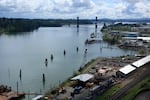
More than a hundred parties share responsibility for cleaning up the highly polluted 10-mile stretch of the Willamette River known as the Portland Harbor Superfund Site.
Cassandra Profita/OPB / EarthFix
Officials with the U.S. Environmental Protection Agency are proposing to scale back the scope and cost of the Portland Harbor Superfund cleanup.
They say new research shows one of the pollutants at the site is actually less toxic than than they thought.
The cancer-causing chemical known as benzo(a)pyrene comes from burning things like coal and oil, and it's part of a larger class of pollutants known as polyaromatic hydrocarbons, or PAH.
A 10-mile stretch of the Willamette River known as the Portland Harbor Superfund Site is highly contaminated with dozens of pollutants left behind by more than a century of industry in the Portland area.
The EPA spent 16 years developing a $1 billion cleanup plan for the site based on the health and environmental risks of the pollution there.
Now, agency officials say they have new research showing that this one key pollutant is about seven times less toxic to people than the cleanup plans assumed. That means the agency can scale back the amount of cleanup required and cut the estimated cost by $35 million.
“Today’s proposal ensures that the cleanup plan is current with the latest science to protect people’s health and the environment,” acting EPA Administrator Andrew Wheeler said in a statement. “We are moving the cleanup forward to return the Lower Willamette to a healthier working waterway for all.”
The proposal changes the target levels for certain PAHs in the river’s beaches and sediment, so the cleanup will require less dredging and capping of soil in and around the river. It will also shrink the footprint of overall cleanup area by about 17 acres out of the total 2,200 acres, according to the EPA.
Portland Harbor project manager Sean Sheldrake said it's unusual for new research to show that a chemical is less toxic than previously thought.
"Where we thought we had to do more to make things safe with respect to this chemical we can actually do less active cleanup," he said. "The state of the science is indicating it's not as hazardous as we previously thought."
Sheldrake said the new research was finalized around the same time as the record of decision for the Portland Harbor cleanup. The findings don't mean there won't be any cleanup of PAHs in the river, he said, but there will be less than planned in certain areas — namely around NW Natural's Gasco site and the Port of Portland's Terminal 4.
"Adjustments in our level of knowledge of toxicity do happen regularly," he said. "It just usually doesn't go in this direction."
Bob Sallinger, conservation director with the Portland Audubon Society, said his group doesn't think the existing plan calls for as much cleanup as it should. The last thing he wanted was for the EPA to roll back cleanup requirements that are already in the plan.
"It's disappointing, because it took EPA 16 years to develop a cleanup plan and we were hopeful we were moving into the cleanup phase now," Sallinger said. "This feels like a big step backwards. It weakens the plan."
The EPA was initially accepting public comments on its proposal for 30 days. The Portland Audubon Society and others asked for an extension of that time window to review the science and comment on how the findings will affect the cleanup. On Monday afternoon, the EPA agreed to extend the public comment period until Dec. 21.
